Damage Detection Using Ultrasonic Techniques in Concrete-Filled Steel Tubes (CFSTs) Columns
Abstract
:1. Introduction
2. Materials and Methods
2.1. Preparation of Samples
2.2. Experimental Setup
2.3. Computational Algorithms
2.3.1. Fast Fourier Transform and Short-Time Fourier Transform
2.3.2. Broadband Ultrasound Attenuation Analysis
3. Results and Discussion
3.1. FFT and STFT C-Scan Results
3.2. BUA C-Scan Results
4. Conclusions
Author Contributions
Funding
Institutional Review Board Statement
Informed Consent Statement
Acknowledgments
Conflicts of Interest
Abbreviations
| CFSTs | Concrete-filled steel tubes |
| BUA | Broadband Ultrasound Attenuation |
| CFST | Concrete-Filled Steel Tubular |
| UPV | Ultrasonic pulse velocity method |
| HL | Hull/Langton index |
| FFT | Fast Fourier Transform |
| STFT | Short-time Fourier transform |
References
- Han, L.H.; Li, W.; Bjorhovde, R. Developments and advanced applications of concrete-filled steel tubular (CFST) structures: Members. J. Constr. Steel Res. 2014, 100, 211–228. [Google Scholar] [CrossRef]
- Tao, Z.; Uy, B.; Han, L.H.; Wang, Z.B. Analysis and design of concrete-filled stiffened thin-walled steel tubular columns under axial compression. Thin Walled Struct. 2009, 47, 1544–1556. [Google Scholar] [CrossRef]
- Oh, B.K.; Park, J.S.; Choi, S.W.; Park, H.S. Design model for analysis of relationships among CO2 emissions, cost, and structural parameters in green building construction with composite columns. Energy Build. 2016, 118, 301–315. [Google Scholar] [CrossRef]
- Figueirido, D.H. Estudio Experimental del Pandeo de Perfiles Tubulares Rectangulares de Acero, Rellenos de Hormigón de Alta Resistencia, Bajo Carga Axial y Diagrama de Momentos Variables. Ph.D. Thesis, Universitat Politècnica de València, Valencia, Spain, 2012. [Google Scholar]
- Al Zand, A.W.; Badaruzzaman, W.H.W.; Al-Shaikhli, M.S.; Ali, M.M. Flexural performance of square concrete-filled steel tube beams stiffened with V-shaped grooves. J. Constr. Steel Res. 2020, 166, 105930. [Google Scholar] [CrossRef]
- Al-Zand, A.W.; Badaruzzaman, W.W.; Ali, M.M.; Hasan, Q.A.; Al-Shaikhli, M.S. Flexural performance of cold-formed square CFST beams strengthened with internal stiffeners. Steel Compos. Struct. Int. J. 2020, 34, 123–139. [Google Scholar]
- Xu, P.; Wang, Z.; Mou, B.; Gao, D. Seismic performance of CFST column to steel beam joint with outer annular stiffener. J. Build. Eng. 2022, 54, 104679. [Google Scholar] [CrossRef]
- Climent, M.Á.; Miró, M.; Eiras, J.N.; Poveda, P.; de Vera, G.; Segovia, E.G.; Ramis, J. Early Detection of Corrosion-Induced Concrete Micro-cracking by Using Nonlinear Ultrasonic Techniques: Possible Influence of Mass Transport Processes. Corros. Mater. Degrad. 2022, 3, 235–257. [Google Scholar] [CrossRef]
- Miró, M.; Eiras, J.N.; Poveda, P.; Climent, M.Á.; Ramis, J. Detecting cracks due to steel corrosion in reinforced cement mortar using intermodulation generation of ultrasonic waves. Constr. Build. Mater. 2021, 286, 122915. [Google Scholar] [CrossRef]
- Liao, F.Y.; Han, L.H.; Tao, Z. Behaviour of CFST stub columns with initial concrete imperfection: Analysis and calculations. Thin Walled Struct. 2013, 70, 57–69. [Google Scholar] [CrossRef]
- Liao, F.Y.; Han, L.H.; He, S.H. Behavior of CFST short column and beam with initial concrete imperfection: Experiments. J. Constr. Steel Res. 2011, 67, 1922–1935. [Google Scholar] [CrossRef]
- Lu, Z.; Guo, C.; Li, G. Air void and ring gap effect on CFST arch bridges dynamic performance. J. Constr. Steel Res. 2021, 177, 106418. [Google Scholar] [CrossRef]
- Han, L.H. The influence of concrete compaction on the strength of concrete filled steel tubes. Adv. Struct. Eng. 2000, 3, 131–137. [Google Scholar] [CrossRef]
- Han, L.H.; Yao, G.H. Influence of concrete compaction on the strength of concrete-filled steel RHS columns. J. Constr. Steel Res. 2003, 59, 751–767. [Google Scholar] [CrossRef]
- Guo, C.; Lu, Z. A Comprehensive Research of the Air-void Defect of Concrete-filled Steel Tube. Period. Polytech. Civ. Eng. 2021, 65, 474–485. [Google Scholar] [CrossRef]
- Guo, C.; Lu, Z. CFST Rib with Circumferential Gap and SWS Composite Defects. Iran. J. Sci. Technol. Trans. Civ. Eng. 2021, 45, 1441–1456. [Google Scholar] [CrossRef]
- Selleck, S.F.; Landis, E.N.; Peterson, M.L.; Shah, S.P.; Achenbach, J.D. Ultrasonic investigation of concrete with distributed damage. Mater. J. 1998, 95, 27–36. [Google Scholar]
- Shah, A.; Ribakov, Y. Non-destructive evaluation of concrete in damaged and undamaged states. Mater. Des. 2009, 30, 3504–3511. [Google Scholar] [CrossRef]
- Zhao, M.; Nie, Z.; Wang, K.; Liu, P.; Zhang, X. Nonlinear ultrasonic test of concrete cubes with induced crack. Ultrasonics 2019, 97, 1–10. [Google Scholar] [CrossRef]
- Le, M.; Kim, J.; Kim, S.; Lee, J. B-scan ultrasonic testing of rivets in multilayer structures based on short-time Fourier transform analysis. Measurement 2018, 128, 495–503. [Google Scholar] [CrossRef]
- Petro, J.T., Jr.; Kim, J. Detection of delamination in concrete using ultrasonic pulse velocity test. Constr. Build. Mater. 2012, 26, 574–582. [Google Scholar] [CrossRef]
- Shiotani, T.; Aggelis, D.G. Wave propagation in cementitious material containing artificial distributed damage. Mater. Struct. 2009, 42, 377–384. [Google Scholar] [CrossRef]
- Xu, J.; Wei, H. Ultrasonic testing analysis of concrete structure based on S transform. Shock Vib. 2019, 2019, 2693141. [Google Scholar] [CrossRef]
- Chai, H.; Momoki, S.; Kobayashi, Y.; Aggelis, D.; Shiotani, T. Tomographic reconstruction for concrete using attenuation of ultrasound. NDT E Int. 2011, 44, 206–215. [Google Scholar] [CrossRef]
- Sharma, G.K.; Kumar, A.; Rao, C.B.; Jayakumar, T.; Raj, B. Short time Fourier transform analysis for understanding frequency dependent attenuation in austenitic stainless steel. NDT E Int. 2013, 53, 1–7. [Google Scholar] [CrossRef]
- Mutlib, N.K.; Ismael, M.N.; Baharom, S. Damage Detection in CFST Column by Simulation of Ultrasonic Waves Using STFT-Based Spectrogram and Welch Power Spectral Density Estimate. Struct. Durab. Health Monit. 2021, 15, 227. [Google Scholar] [CrossRef]
- Langton, C.; Palmer, S.; Porter, R. The measurement of broadband ultrasonic attenuation in cancellous bone. Eng. Med. 1984, 13, 89–91. [Google Scholar] [CrossRef] [Green Version]
- Maia, J.M.; Costa, E.T.; Neto, J.F.M.; Button, V.L. Broadband ultrasound attenuation in the calcaneal region: A comparative study of single-position versus scanning systems. IEEE Trans. Ultrason. Ferroelectr. Freq. Control. 2008, 55, 64–73. [Google Scholar] [CrossRef]
- Strelitzki, R.; Evans, J. An investigation of the measurement of broadband ultrasonic attenuation in trabecular bone. Ultrasonics 1996, 34, 785–791. [Google Scholar] [CrossRef]
- Töyräs, J.; Nieminen, M.; Kröger, H.; Jurvelin, J. Bone mineral density, ultrasound velocity, and broadband attenuation predict mechanical properties of trabecular bone differently. Bone 2002, 31, 503–507. [Google Scholar] [CrossRef]
- Tasinkevych, Y.; Falińska, K.; Lewin, P.A.; Litniewski, J. Improving broadband ultrasound attenuation assessment in cancellous bone by mitigating the influence of cortical bone: Phantom and in-vitro study. Ultrasonics 2019, 94, 382–390. [Google Scholar] [CrossRef] [PubMed]
- Chappard, C.; Laugier, P.; Fournier, B.; Roux, C.; Berger, G. Assessment of the relationship between broadband ultrasound attenuation and bone mineral density at the calcaneus using BUA imaging and DXA. Osteoporos. Int. 1997, 7, 316–322. [Google Scholar] [CrossRef]
- Langton, C.; Ali, A.; Riggs, C.; Evans, G.; Bonfield, W. A contact method for the assessment of ultrasonic velocity and broadband attenuation in cortical and cancellous bone. Clin. Phys. Physiol. Meas. 1990, 11, 243. [Google Scholar] [CrossRef]
- Hodgskinson, R.; Njeh, C.; Whitehead, M.; Langton, C. The non-linear relationship between BUA and porosity in cancellous bone. Phys. Med. Biol. 1996, 41, 2411. [Google Scholar] [CrossRef]
- Hull, J.; Langton, C.; Barker, S.; Jones, A. Identification and characterisation of materials by broadband ultrasonic attenuation analysis. J. Mater. Process. Technol. 1996, 56, 148–157. [Google Scholar] [CrossRef]
- Da Costa, R.; Maia, J.M.; Assef, A.A.; Pichorim, S.F.; Gewehr, P.M.; Costa, E.T. Defect Detection in Aluminum Bars Using Impedance and Ultrasonic Attenuation. IEEE Sens. J. 2020, 20, 7400–7413. [Google Scholar] [CrossRef]
- Vergara, L.; Miralles, R.; Gosálbez, J.; Juanes, F.; Ullate, L.; Anaya, J.; Hernández, M.; Izquierdo, M. NDE ultrasonic methods to characterise the porosity of mortar. NDT E Int. 2001, 34, 557–562. [Google Scholar] [CrossRef]
- Iba nez, C.; Hernández-Figueirido, D.; Piquer, A. Shape effect on axially loaded high strength CFST stub columns. J. Constr. Steel Res. 2018, 147, 247–256. [Google Scholar] [CrossRef]
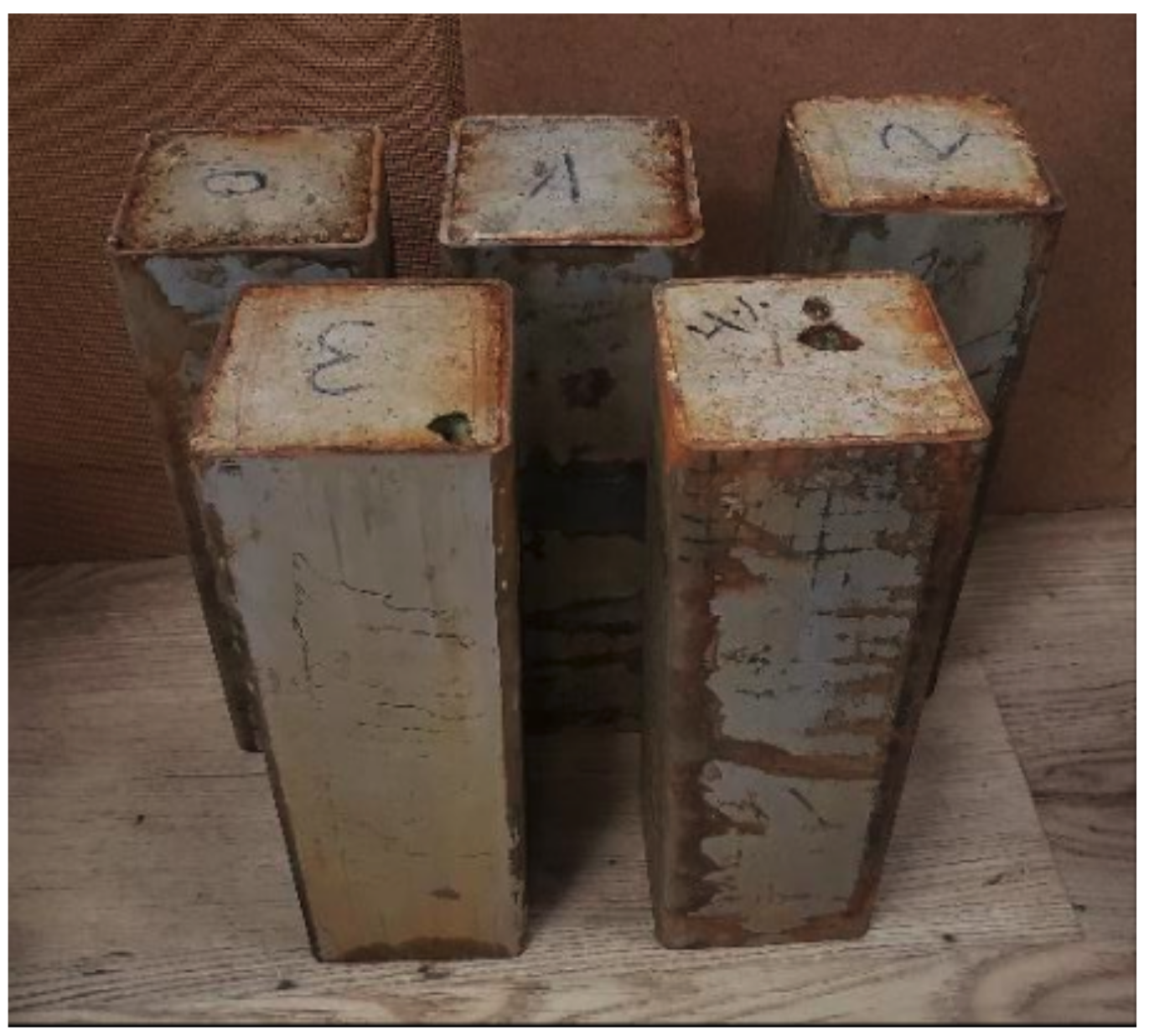
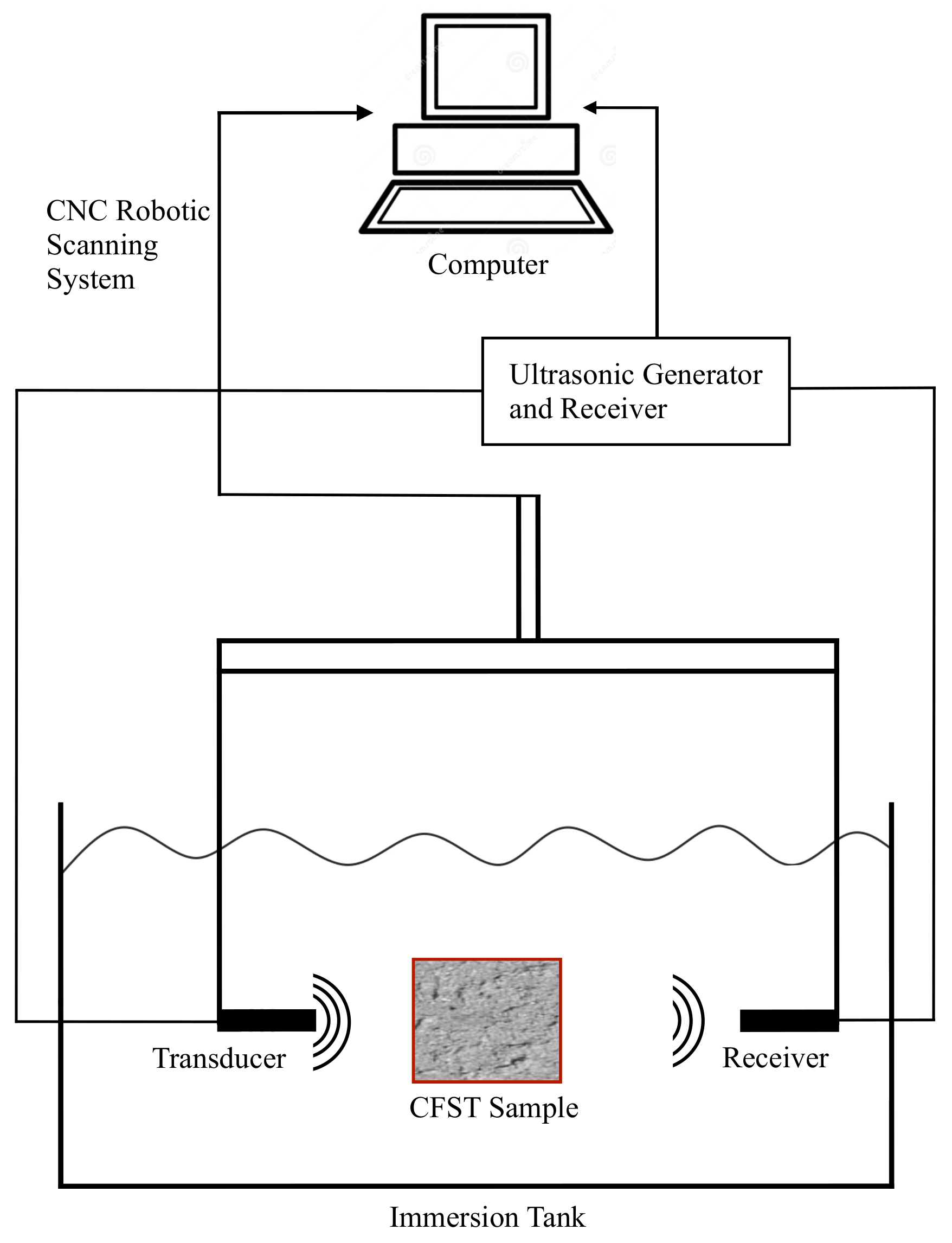


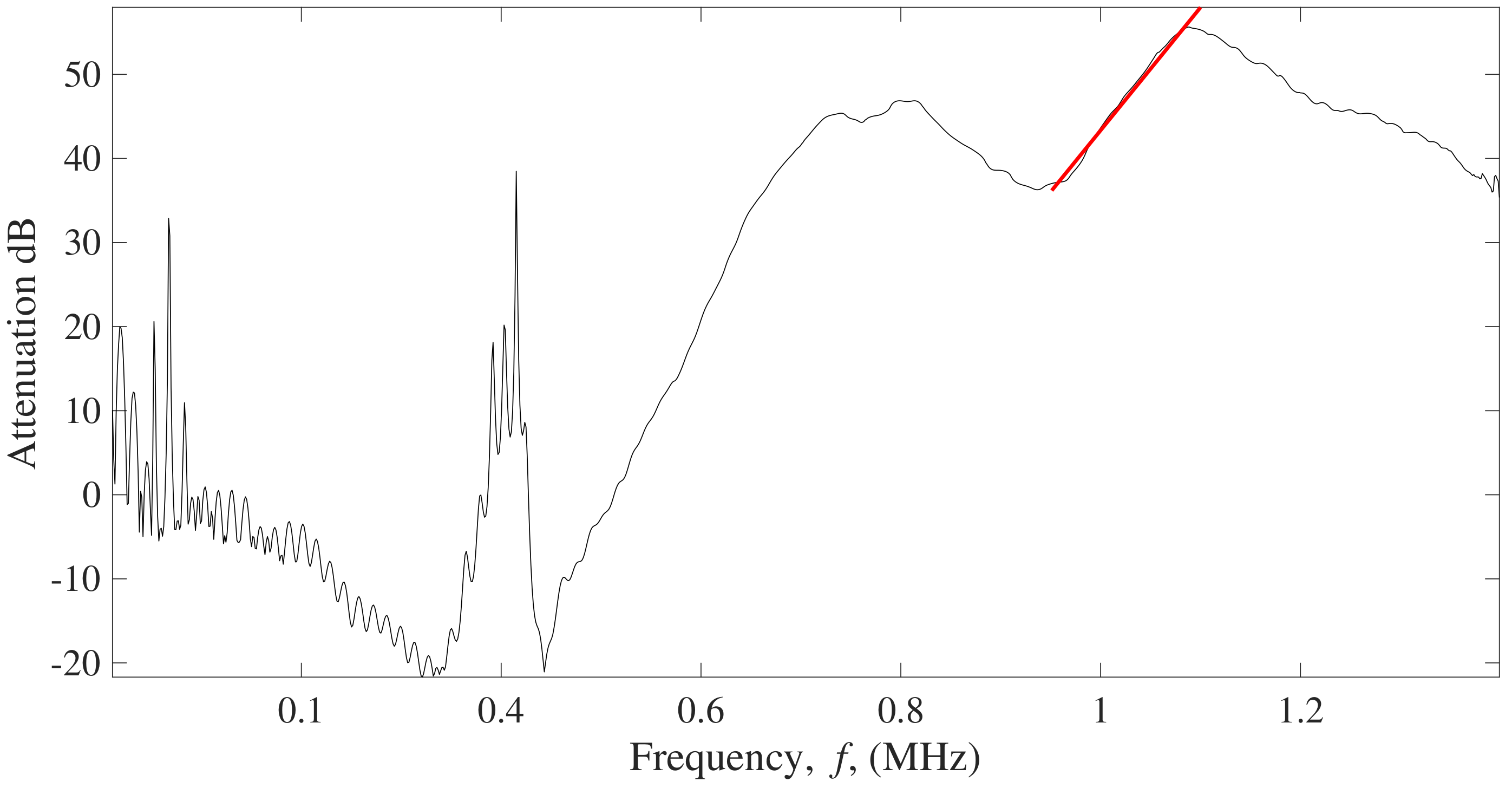

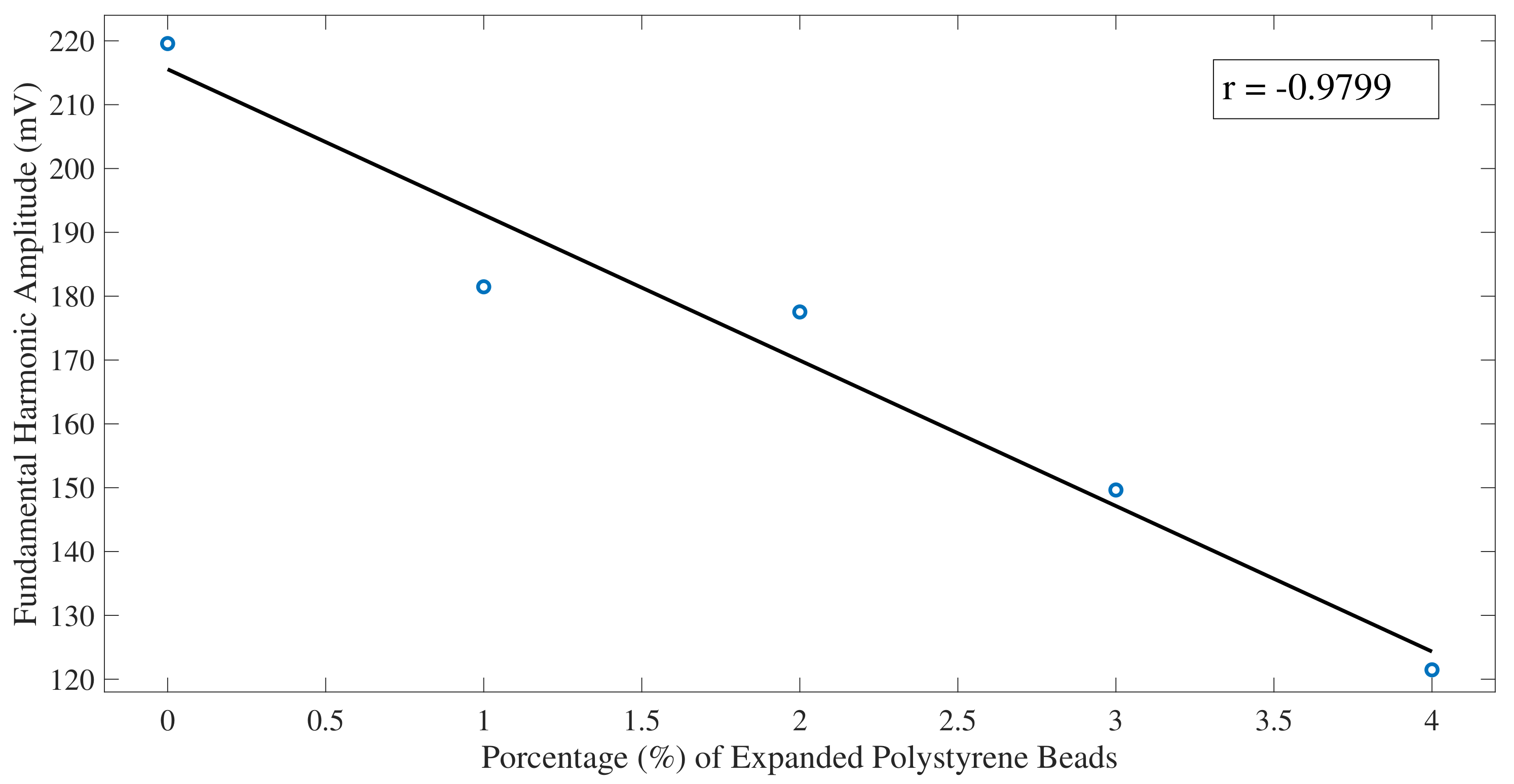


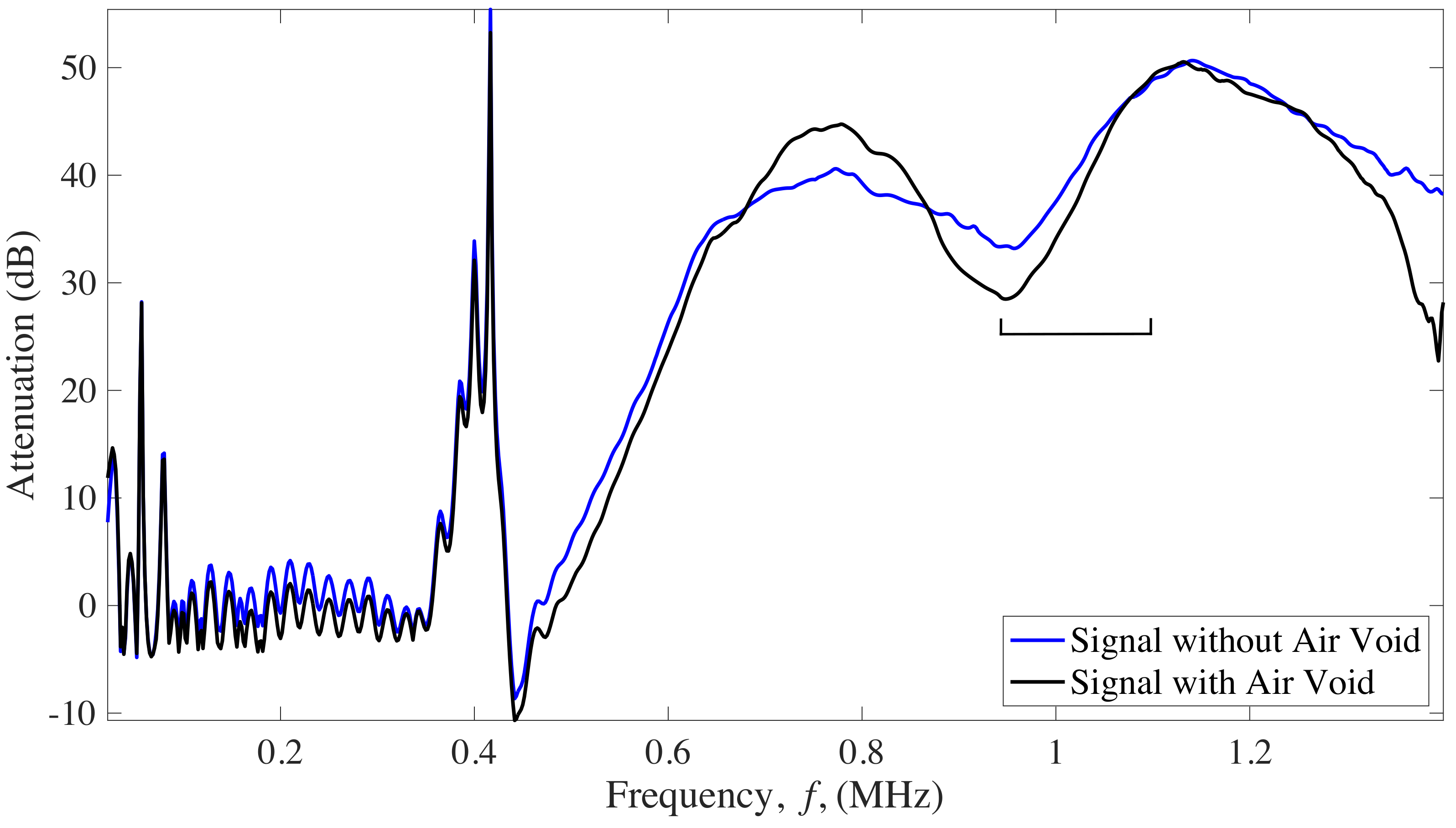
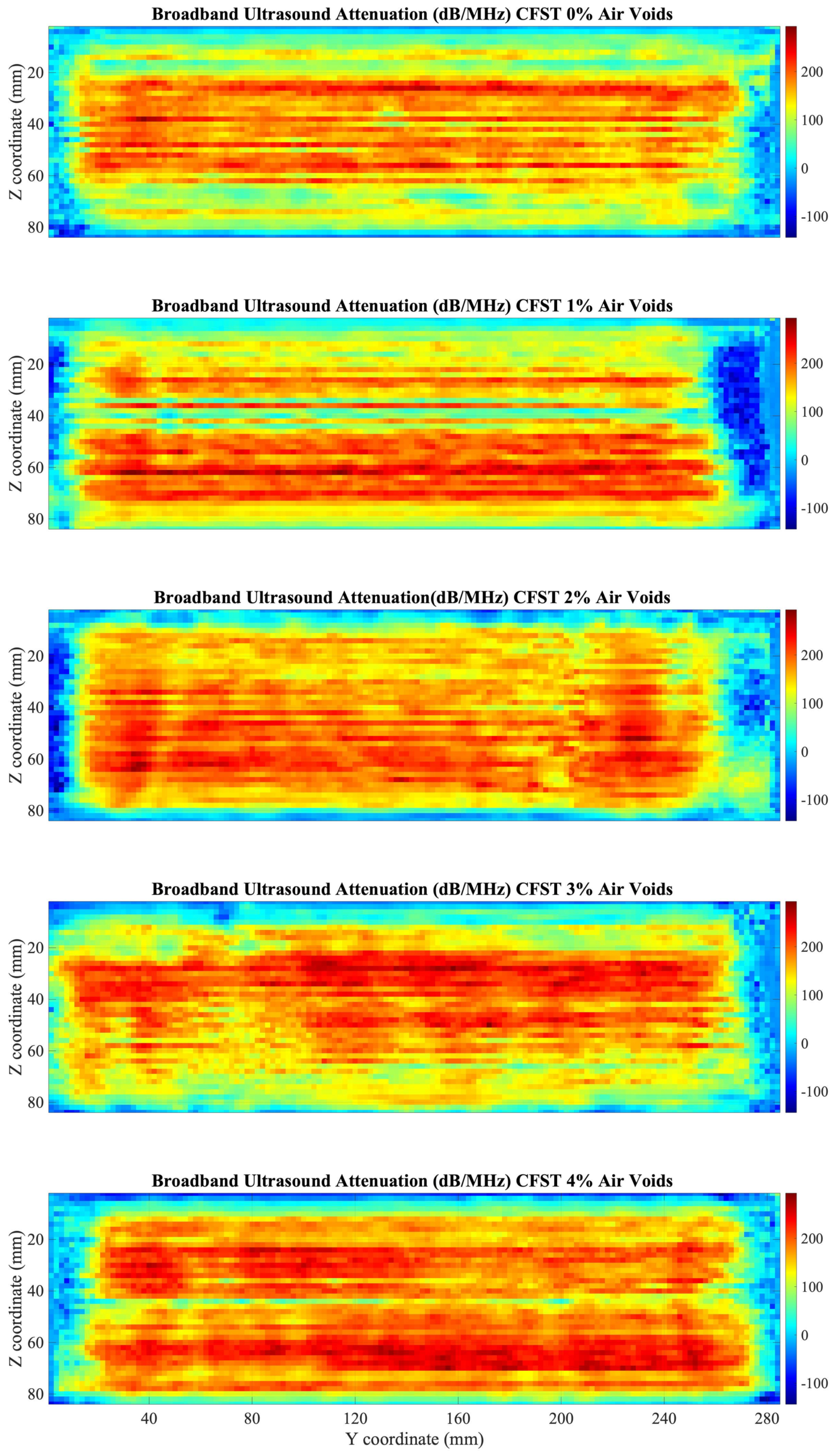
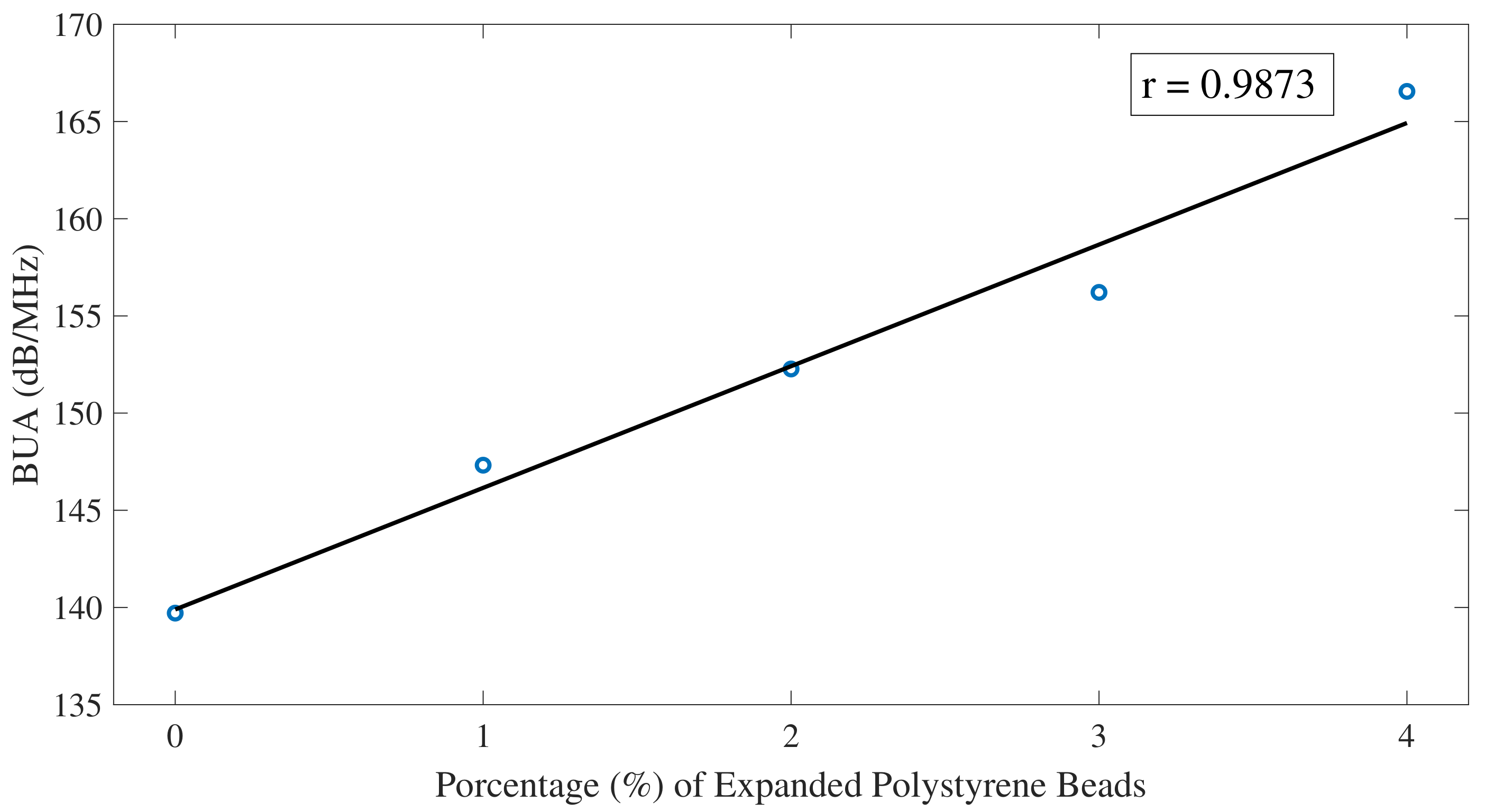
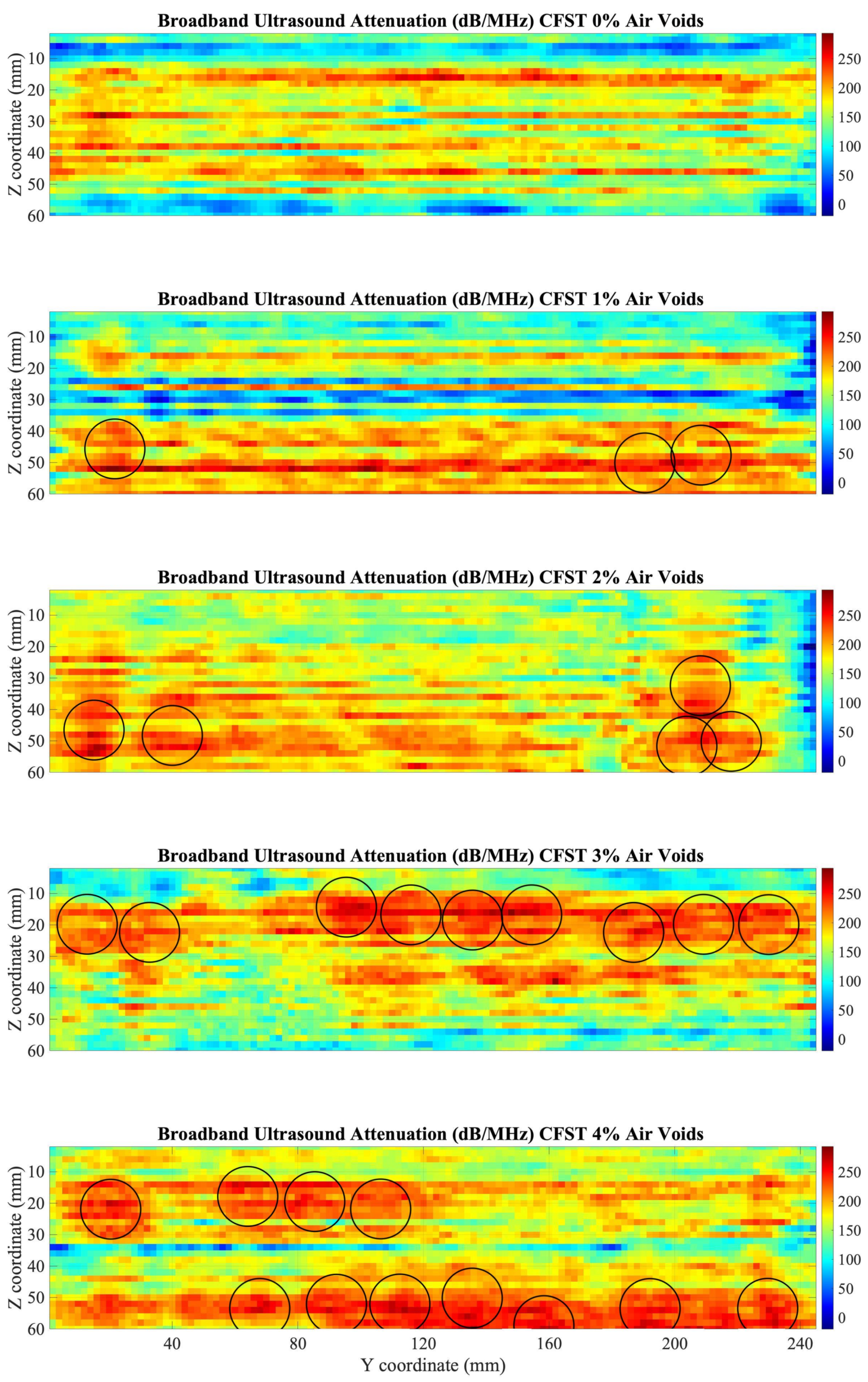
| Percentage of Air Voids | Polystyrene Beads |
|---|---|
| 0% | 0 |
| 1% | 3 |
| 2% | 6 |
| 3% | 9 |
| 4% | 12 |
| Infill | Proportions |
|---|---|
| Cement (kg/m) | 348 |
| Water (l/m) | 220 |
| Sand (kg/m) | 1065 |
| Gravel (kg/m) | 666 |
Publisher’s Note: MDPI stays neutral with regard to jurisdictional claims in published maps and institutional affiliations. |
© 2022 by the authors. Licensee MDPI, Basel, Switzerland. This article is an open access article distributed under the terms and conditions of the Creative Commons Attribution (CC BY) license (https://creativecommons.org/licenses/by/4.0/).
Share and Cite
Callejas, A.; Palma, R.; Hernández-Figueirido, D.; Rus, G. Damage Detection Using Ultrasonic Techniques in Concrete-Filled Steel Tubes (CFSTs) Columns. Sensors 2022, 22, 4400. https://doi.org/10.3390/s22124400
Callejas A, Palma R, Hernández-Figueirido D, Rus G. Damage Detection Using Ultrasonic Techniques in Concrete-Filled Steel Tubes (CFSTs) Columns. Sensors. 2022; 22(12):4400. https://doi.org/10.3390/s22124400
Chicago/Turabian StyleCallejas, Antonio, Roberto Palma, David Hernández-Figueirido, and Guillermo Rus. 2022. "Damage Detection Using Ultrasonic Techniques in Concrete-Filled Steel Tubes (CFSTs) Columns" Sensors 22, no. 12: 4400. https://doi.org/10.3390/s22124400







